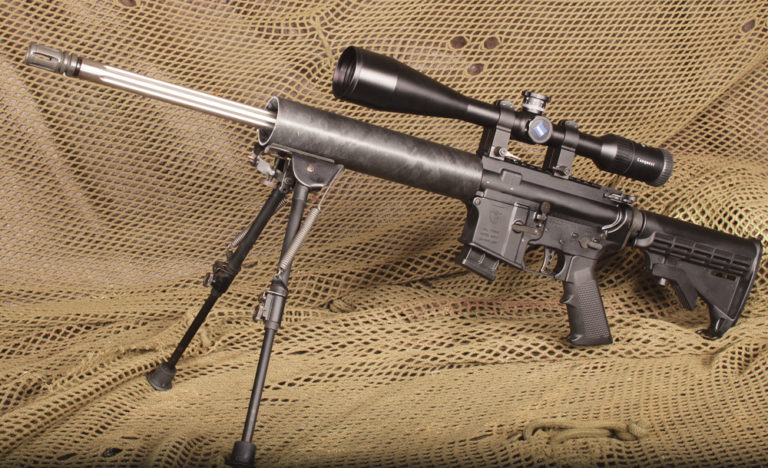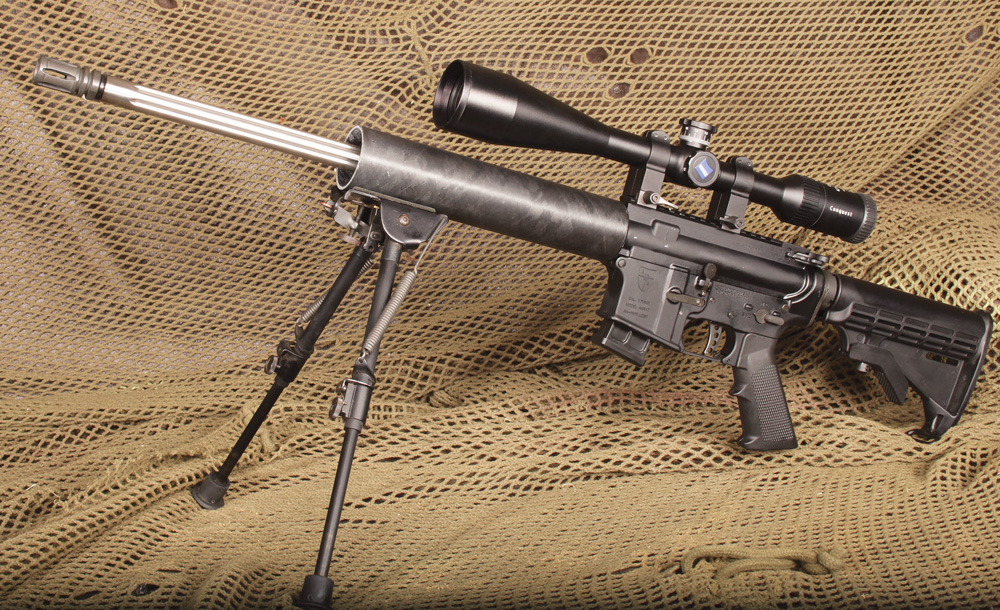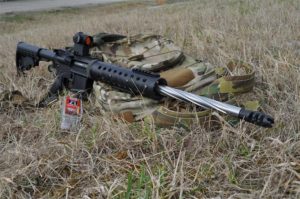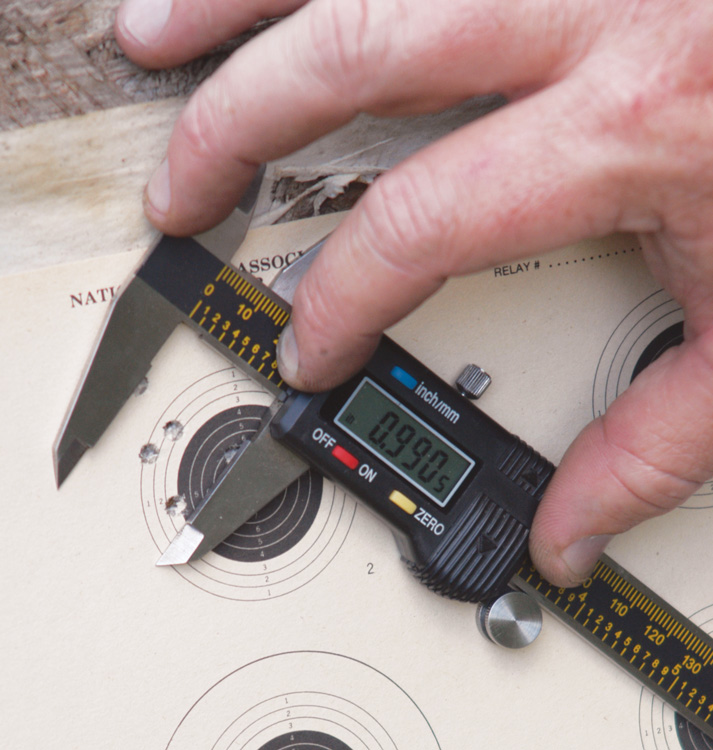

Join the author as he attempts to wreck a pre-production Alexander Arms .17 HMR AR in the pursuit of the ideal pest control rifle.
The first time I shot the .17 HMR cartridge, I was so enamored with it that I didn’t quit until I had fired more than a brick of ammo… one shot at a time through a Thompson/Center Contender rifle.
In three days of hunting, I shot a pickup load of jack rabbits, skunks, coyotes and even a couple of wild turkeys. When a crow flew by 80 yards away in the desolate area, I couldn’t resist but to slide the crosshairs in front of the crow and squeeze the trigger.
My first reaction to the explosion of black feathers was to shout the obligatory “Did you see that!” Instead, I promptly handed the gun to another writer and said that I was finished shooting for the afternoon. I know to quit when I’m ahead.
Birth of the .17 HMR
 Initially, Bill Alexander, the company owner and chief engineer, sent me his first production .17 HMR. He predicted correctly that I would find a bug or two in the early design (that’s long since been fixed), and that we would work through to address them.
Initially, Bill Alexander, the company owner and chief engineer, sent me his first production .17 HMR. He predicted correctly that I would find a bug or two in the early design (that’s long since been fixed), and that we would work through to address them.
Initial conversations about the .17 HMR topic with Alexander, opened my eyes to several things related to this cartridge and the guns that shoot them. With a well-established reputation for building AR rifles in .50 Beowulf and 6.5 Grendel, I was curious as to why he would want to chamber his new rifle in .17 HMR.
When Hornady developed the .17 HMR, they worked with Ruger and Marlin to seek the fastest rimfire cartridge that could produce accurate reliability and economic manufacturing. Some of their parameters included performance beyond that of the .22 WMR in trajectory and velocity and be less susceptible to wind drift.
Similar noise levels were to be maintained, as well as operating at the same case pressure. Frangible bullets that weren’t as susceptible to ricochet also were specified. All of this was packaged in a cartridge that was designed to shoot less than a minute of angle or better. A lesser-known requirement was that the cartridge should produce between 23,000 and 29,000 copper units of pressure (CUP).
Several companies initially chambered their rifles for the new cartridge, but the .17 HMR’s pressure and thin case didn’t adapt too well. Some stronger semi-auto designs seem to be withstanding the pressure, but Remington was quick to issue a recall of their bolt-action Model 597s chambered in .17 HMR. Others followed suit.
“The AR is so massively overbuilt that it just keeps on ticking,” Alexander said, “whereas a 597 blows up.”

Build and Destroy
Along came Alexander Arms with a new AR in .17 HMR. Since I was the recipient of the first test rifle released from the factory, my assignment was to ferret out any bugs or create them through hard use and abuse. I had previously learned the cartridge’s limitations on game, so I focused on what it would take to put the little AR out of action.
I acquired a supply of CCI, Hornady and Winchester .17 HMR ammo. My experience with .17 centerfire rifles has taught me that accuracy suffers when the bore gets dirty. As few as 20 shots can warrant a cleaning to keep accuracy up to standards.
Gumming up a semi-auto action would be rather easy, so I wanted to learn just how many rounds it would take to bring shooting to a halt. If I had a cartridge case fail, I wanted to learn what would happen as well. To say that I abused the Alexander Arms .17 HMR falls far short of what I did. I ran this rifle hot and kept pouring the rounds downrange. Along the way, I found out what happens when a case ruptures.
It doesn’t take long to heat this rifle up. Firing the 17-grain Hornady loads across a Shooting Crony, my first 10 rounds averaged 2,654 fps. The next 10 rounds climbed in velocity to an average of 2,678 fps, and by the time I ran the third magazine full through the chronograph it averaged 2,703 fps.
As best as I can determine, the chamber acts as a heat sink, and when a round gets chambered it heats up quickly. When the hammer drops on a heated case, velocities and pressures rise. It didn’t help that my shooting sessions were conducted on days that the temperature hovered around 100 degrees, either.
After 300 rounds down range as fast as I could fire, loads and change magazines, the gun was both dirty and hot. Case heads started blowing on the case rim on at least three rounds.
It “stove piped” the blown cases and the gun spewed smoke through the ejection port. Several magazines later, I had a full-blown case rupture that lodged a bullet in the barrel. The magazine suffered from the experience, but I didn’t.
The plastic on the magazine’s feed lips took a beating, which reduced the feeding reliability of the magazine. Pieces of the magazine also fell in the trigger well preventing the trigger disconnector from working properly. Removing the debris quickly solved the problem.
The extractor took a beating, too. It was bent up and locked the bolt back. A quick field stripping got the magazine well insert out of the gun. Some minor surgery with a Gerber multi-tool bent the extractor back into position. Since I didn’t have a .17-caliber cleaning rod at the range, I had to wait to dislodge it from the barrel.
Shortly thereafter, I called Alexander to report mission accomplished: rifle wrecked. He was ready to make a house call, inspect the rifle, fix it or bring another one to abuse. And wreck it we did. The day Alexander arrived we went to the range and ran the gun fast, hot and dirty.
We got the gun to repeat its cartridge failures without any major mishaps. Blown cases had the penchant for bending the ejector bar, but he fixed it on the rangeww with a pair of pliers. When the round count got to approximately 450 without cleaning, case extraction and feeding became so sluggish that it was reduced to a single-shot.
Curtain Call
After a thorough cleaning, the little rifle produced some admirable groups. At 100 yards, it was capable of keeping five shots under an inch. The gun’s favorite load was Hornady’s 20-grain load, which produced a five-shot group as small as 0.442-inch.
Subsequent to my testing, Alexander incorporated a couple of design changes to improve performance. The extractor claw, ejector and magazines were tweaked, and today’s production rifle runs flawlessly.
A three-day ground squirrel shoot in Oregon last spring with another Alexander Arms .17 HMR proved it. The gun digested more than 1,200 rounds without a hiccup, only needing a scrubbing after 300 rounds or so.
The .17 HMR is a hot number that’s a lot of fun to shoot. Wrap an Alexander Arms AR around it and you’ll have a tack-driving rifle that will handle anything that the cartridge is capable of tackling.
Alexander Arms .17 HMR
Caliber: .17 HMR
Action Type: semi-auto
Receiver:
N/A
Barrel:
18-in. stainless, button-rifled 1:10 twist with straight flutes
Magazine:
10-round AR-style (2)
Trigger:
Mil-spec Ar-15 trigger, 7-pound pull
Sights:
Picatinny rail for mounting optics
Stock: G10 composite, non-vented, mid-length, free-floating tube handguard, six-position adjustable stock
Weight:
6.88 lbs.
Overall Length: 37 1/8 in.
Accessories:
six-vent A1 flash hider,
soft carry bag
Suggested Retail Price: $1,110
Website: alexanderarms.com
Expand Your Knowledge on .17 HMR
- Top Picks for the Most Accurate .17 HMR Rifle
- A Look at the Best .17 HMR Pistols Available Today
- Breaking Down .17 HMR vs .22 Mag Accuracy for Target Shooting
- .17 HMR vs .17 WSM Accuracy – Which is More Precise?
- A Guide to Choosing the Best .17 HMR Ammo
Editor's Note: This article appeared in the May 20, 2013 issue of Gun Digest the Magazine.

Next Step: Get your FREE Printable Target Pack
Enhance your shooting precision with our 62 MOA Targets, perfect for rifles and handguns. Crafted in collaboration with Storm Tactical for accuracy and versatility.
Subscribe to the Gun Digest email newsletter and get your downloadable target pack sent straight to your inbox. Stay updated with the latest firearms info in the industry.

![Best Concealed Carry Guns In 2025 [Field Tested] Wilson Combat EDC X9S 1](https://gundigest.com/wp-content/uploads/Wilson-Combat-EDC-X9S-1-324x160.jpg)


![Best 9mm Carbine: Affordable PCCs [Tested] Ruger Carbine Shooting](https://gundigest.com/wp-content/uploads/Ruger-Carbine-Shooting-100x70.jpg)
![Best AR-15: Top Options Available Today [Field Tested] Harrington and Richardson PSA XM177E2 feature](https://gundigest.com/wp-content/uploads/Harrington-and-Richardson-PSA-XM177E2-feature-100x70.jpg)

Holly Horse Monkeys!
$1100. for a .17 ouch
I have a Savage .17hmr HB that I have been shooting for years and love that little rocket.
Total package with scope was less then $400. Quite a bit less.
Good read and was wondering if they would ever consider making this rifle in the 5MM round. I have the old Remington 5MM and it puts the groundhogs down with no problems. Nice to have someone again making the 5MM ammo so I can shoot it again.